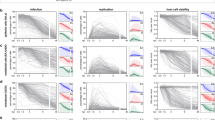Abstract.
Staphylococcus aureus is the primary etiological agent of several human diseases. S. aureus has classically been considered an extracellular pathogen; however, recent evidence indicates that S. aureus invades and persists in non-professional phagocytes. Experiments demonstrate that actin microfilaments, microtubules, receptor-mediated endocytosis, and protein tyrosine kinases play important roles in the uptake of S. aureus. Fibronectin-binding proteins and β1-integrins are implicated as critical cell surface molecules associated with internalization of S. aureus by non-phagocytic cells. Following invasion of eukaryotic cells, S. aureus induces the release of cytokines that have the potential to exacerbate disease and induce apoptosis. Finally, S. aureus has the ability to persist inside host cells as small colony variants, a phenotype associated with persistent and recurrent infections.
Similar content being viewed by others
Author information
Authors and Affiliations
Additional information
Received revision: 26 April 2001
Electronic Publication
Rights and permissions
About this article
Cite this article
Alexander, .E., Hudson, .M. Factors influencing the internalization of Staphylococcus aureus and impacts on the course of infections in humans. Appl Microbiol Biotechnol 56, 361–366 (2001). https://doi.org/10.1007/s002530100703
Received:
Accepted:
Issue Date:
DOI: https://doi.org/10.1007/s002530100703




